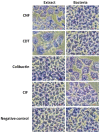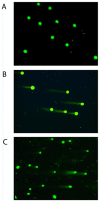High prevalence of mucosa-associated E. coli producing cyclomodulin and genotoxin in colon cancer
- PMID: 23457644
- PMCID: PMC3572998
- DOI: 10.1371/journal.pone.0056964
High prevalence of mucosa-associated E. coli producing cyclomodulin and genotoxin in colon cancer
Abstract
Some Escherichia coli strains produce toxins designated cyclomodulins (CMs) which interfere with the eukaryotic cell cycle of host cells, suggesting a possible link between these bacteria and cancers. There are relatively few data available concerning the colonization of colon tumors by cyclomodulin- and genotoxic-producing E. coli. We did a qualitative and phylogenetic analysis of mucosa-associated E. coli harboring cyclomodulin-encoding genes from 38 patients with colorectal cancer (CRC) and 31 with diverticulosis. The functionality of these genes was investigated on cell cultures and the genotoxic activity of strains devoid of known CM-encoding gene was investigated. Results showed a higher prevalence of B2 phylogroup E. coli harboring the colibatin-producing genes in biopsies of patients with CRC (55.3%) than in those of patients with diverticulosis (19.3%), (p<0.01). Likewise, a higher prevalence of B2 E. coli harboring the CNF1-encoding genes in biopsies of patients with CRC (39.5%) than in those of patients with diverticulosis (12.9%), (p = 0.01). Functional analysis revealed that the majority of these genes were functional. Analysis of the ability of E. coli to adhere to intestinal epithelial cells Int-407 indicated that highly adherent E. coli strains mostly belonged to A and D phylogroups, whatever the origin of the strains (CRC or diverticulosis), and that most E. coli strains belonging to B2 phylogroup displayed very low levels of adhesion. In addition, 27.6% (n = 21/76) E. coli strains devoid of known cyclomodulin-encoding genes induced DNA damage in vitro, as assessed by the comet assay. In contrast to cyclomodulin-producing E. coli, these strains mainly belonged to A or D E. coli phylogroups, and exhibited a non significant difference in the distribution of CRC and diverticulosis specimens (22% versus 32.5%, p = 0.91). In conclusion, cyclomodulin-producing E. coli belonging mostly to B2 phylogroup colonize the colonic mucosa of patients with CRC.
Conflict of interest statement
Figures




Similar articles
-
Colon cancer-associated B2 Escherichia coli colonize gut mucosa and promote cell proliferation.World J Gastroenterol. 2014 Jun 7;20(21):6560-72. doi: 10.3748/wjg.v20.i21.6560. World J Gastroenterol. 2014. PMID: 24914378 Free PMC article.
-
Mucosa-Associated Escherichia coli in Colorectal Cancer Patients and Control Subjects: Variations in the Prevalence and Attributing Features.Can J Infect Dis Med Microbiol. 2021 Nov 9;2021:2131787. doi: 10.1155/2021/2131787. eCollection 2021. Can J Infect Dis Med Microbiol. 2021. PMID: 34795808 Free PMC article.
-
Cyclomodulins in urosepsis strains of Escherichia coli.J Clin Microbiol. 2010 Jun;48(6):2122-9. doi: 10.1128/JCM.02365-09. Epub 2010 Apr 7. J Clin Microbiol. 2010. PMID: 20375237 Free PMC article.
-
Colibactin: More Than a New Bacterial Toxin.Toxins (Basel). 2018 Apr 10;10(4):151. doi: 10.3390/toxins10040151. Toxins (Basel). 2018. PMID: 29642622 Free PMC article. Review.
-
Adherent-invasive Escherichia coli in inflammatory bowel disease.Inflamm Bowel Dis. 2007 Oct;13(10):1277-83. doi: 10.1002/ibd.20176. Inflamm Bowel Dis. 2007. PMID: 17476674 Review.
Cited by
-
Sticky situation: how adhesive bacteria drive colon cancer.Nature. 2024 Nov;635(8038):298-299. doi: 10.1038/d41586-024-03285-6. Nature. 2024. PMID: 39506166 No abstract available.
-
Colibactin-driven colon cancer requires adhesin-mediated epithelial binding.Nature. 2024 Nov;635(8038):472-480. doi: 10.1038/s41586-024-08135-z. Epub 2024 Nov 6. Nature. 2024. PMID: 39506107
-
Cyclomodulins-harboring Escherichia coli isolated from obese and normal-weight subjects induces intestinal dysplasia in a mouse model.World J Microbiol Biotechnol. 2024 Nov 2;40(12):371. doi: 10.1007/s11274-024-04176-8. World J Microbiol Biotechnol. 2024. PMID: 39487241
-
Escherichia coli on colorectal cancer: A two-edged sword.Microb Biotechnol. 2024 Oct;17(10):e70029. doi: 10.1111/1751-7915.70029. Microb Biotechnol. 2024. PMID: 39400440 Free PMC article. Review.
-
Role of Gut Microbiota in Predisposition to Colon Cancer: A Narrative Review.Indian J Microbiol. 2024 Sep;64(3):1-13. doi: 10.1007/s12088-024-01242-5. Epub 2024 Mar 29. Indian J Microbiol. 2024. PMID: 39282181 Review.
References
-
- Karsa LV, Lignini TA, Patnick J, Lambert R, Sauvaget C (2010) The dimensions of the CRC problem. Best Pract Res Clin Gastroenterol 24: 381–396. - PubMed
-
- Kwak EL, Chung DC (2007) Hereditary colorectal cancer syndromes: an overview. Clin Colorectal Cancer 6: 340–344. - PubMed
-
- Collins D, Hogan AM, Winter DC (2011) Microbial and viral pathogens in colorectal cancer. Lancet Oncol 12: 504–512. - PubMed
-
- Swidsinski A, Khilkin M, Kerjaschki D, Schreiber S, Ortner M, et al. (1998) Association between intraepithelial Escherichia coli and colorectal cancer. Gastroenterology 115: 281–286. - PubMed
Publication types
MeSH terms
Substances
Grants and funding
LinkOut - more resources
Full Text Sources
Other Literature Sources


